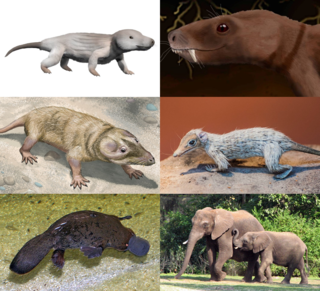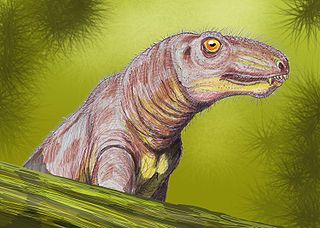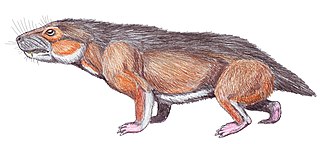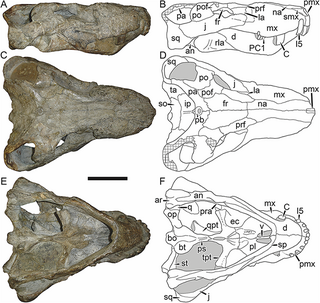
Synapsida is a diverse group of tetrapod vertebrates that includes all mammals and their extinct relatives. It is one of the two major clades of the group Amniota, the other being the more diverse group Sauropsida. Unlike other amniotes, synapsids have a single temporal fenestra, an opening low in the skull roof behind each eye socket, leaving a bony arch beneath each; this accounts for the name "synapsid". The distinctive temporal fenestra developed about 318 million years ago during the Late Carboniferous period, when synapsids and sauropsids diverged, but was subsequently merged with the orbit in early mammals.

Therapsida is a clade comprising a major group of eupelycosaurian synapsids that includes mammals and their ancestors and close relatives. Many of the traits today seen as unique to mammals had their origin within early therapsids, including limbs that were oriented more underneath the body, resulting in a more "standing" quadrupedal posture, as opposed to the lower sprawling posture of many reptiles and amphibians.

Cynodontia is a clade of eutheriodont therapsids that first appeared in the Late Permian, and extensively diversified after the Permian–Triassic extinction event. Mammals are cynodonts, as are their extinct ancestors and close relatives (Mammaliaformes), having evolved from advanced probainognathian cynodonts during the Late Triassic.

Sauropsida is a clade of amniotes, broadly equivalent to the class Reptilia, though typically used in a broader sense to also include extinct stem-group relatives of modern reptiles and birds. The most popular definition states that Sauropsida is the sibling taxon to Synapsida, the other clade of amniotes which includes mammals as its only modern representatives. Although early synapsids have historically been referred to as "mammal-like reptiles", all synapsids are more closely related to mammals than to any modern reptile. Sauropsids, on the other hand, include all amniotes more closely related to modern reptiles than to mammals. This includes Aves (birds), which are recognized as a subgroup of archosaurian reptiles despite originally being named as a separate class in Linnaean taxonomy.

Caseasauria is one of the two main clades of early synapsids, the other being the Eupelycosauria. Caseasaurs are currently known only from the Late Carboniferous and the Permian, and include two superficially different families, the small insectivorous or carnivorous Eothyrididae, and the large, herbivorous Caseidae. These two groups share a number of specialised features associated with the morphology of the snout and external naris.
James Allen Hopson is an American paleontologist and professor at the University of Chicago. His work has focused on the evolution of the synapsids, and has been focused on the transition from basal synapsids to mammals, from the late Paleozoic through the Mesozoic Eras. He received his doctorate at Chicago in 1965, and worked at Yale before returning to Chicago in 1967 as a faculty member in Anatomy, and has also been a research associate at the Field Museum of Natural History since 1971. He has also worked on the paleobiology of dinosaurs, and his work, along with that of Peter Dodson, has become a foundation piece for the modern understanding of duckbill crests, social behavior, and variation.

Microurania is an extinct genus of therapsids from the Middle Permian first named and described by Mikhaïl Ivakhnenko. It is known from a single partial skull found in the region of Orenburg, Russia. According to Kammerer, 2011, it likely represents the remains of a juvenile dinocephalian.
Admetophoneus is a dubious genus of non-mammalian synapsid from Russia. Its type and only species is Admetophoneus kargalensis.
Calleonasus is an extinct genus of non-mammalian synapsid from the Anisian Donguz Formation of Russia.
Eosyodon is a dubious genus of extinct non-mammalian synapsids from the Permian of Texas. Its type and only species is Eosyodon hudsoni. Though it was originally interpreted as an early therapsid, it is probably a member of Sphenacodontidae, the family of synapsids that includes Dimetrodon.
Elatosaurus is an extinct genus of non-mammalian synapsid.
Emydorhinus is an extinct genus of non-mammalian synapsid.
Ictidostoma is an extinct genus of non-mammalian synapsids known from the Tropidostoma Assemblage Zone.

Milosaurus is an extinct genus of non-mammalian synapsids native to Illinois that was alive during the latest Carboniferous and earliest Permian. It was named in 1970 on the basis of FMNH 701, a partial skeleton, as well as referred material.
Notosyodon is an extinct genus of non-mammalian therapsids. The holotype PIN 2505/1, consists of a partial skull preserving the orbital, occipital, and basicranial regions. Other remains include PIN 2505/2, a right lower incisor, and PIN 2505/3, a left upper postcanine, found associated with the holotype and PIN 2608/1, the anterior half of a left dentary found on the right bank of the Donguz River, near Dolmatovskii Farm, Sol-Iletsk District, Orenburg Region, Russia.
Nitosaurus is an extinct genus of non-mammalian synapsids.
Palemydops is an extinct genus of non-mammalian synapsid.
Scalopolacerta is an extinct genus of non-mammalian synapsids.

Eutheriodontia is a clade of therapsids which appear during the Middle Permian and which includes therocephalians and cynodonts, this latter group including mammals and related forms.

Leontosaurus is an extinct genus of non-mammalian synapsids from the Dicynodon Assemblage Zone, Balfour Formation of South Africa. It contains the single species L. vanderhorsti.








